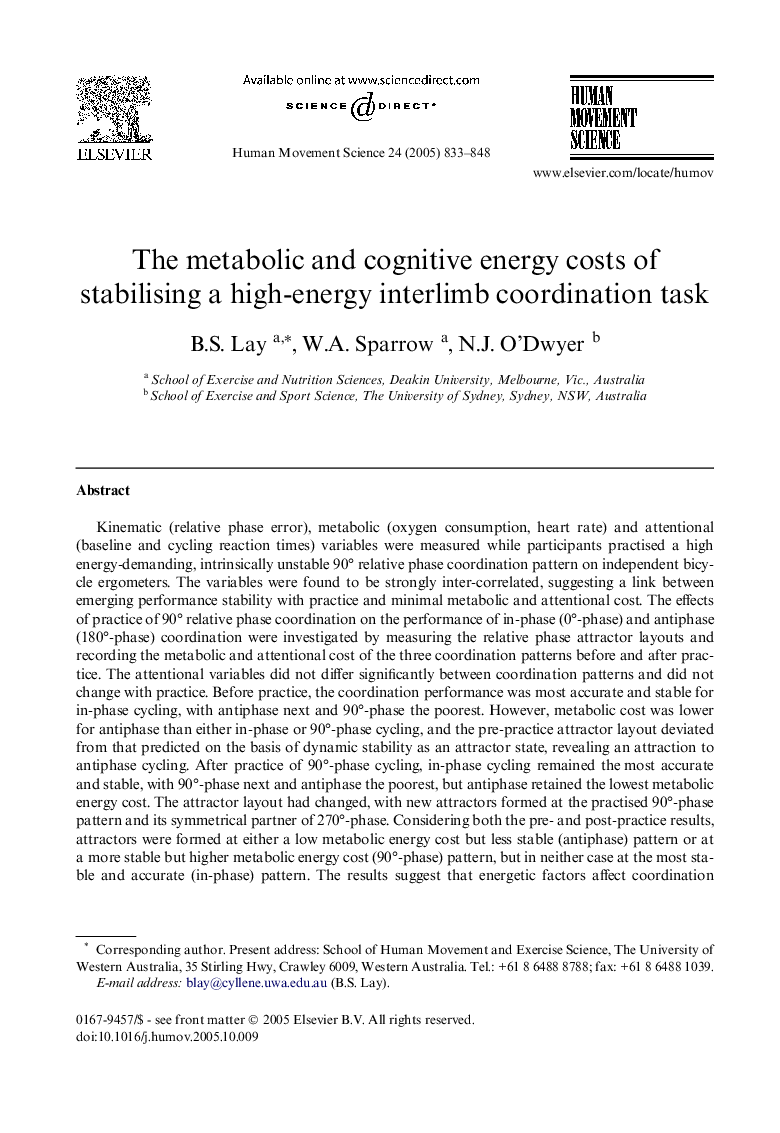| کد مقاله | کد نشریه | سال انتشار | مقاله انگلیسی | نسخه تمام متن |
|---|---|---|---|---|
| 9722461 | 1474235 | 2005 | 16 صفحه PDF | دانلود رایگان |
عنوان انگلیسی مقاله ISI
The metabolic and cognitive energy costs of stabilising a high-energy interlimb coordination task
دانلود مقاله + سفارش ترجمه
دانلود مقاله ISI انگلیسی
رایگان برای ایرانیان
کلمات کلیدی
موضوعات مرتبط
علوم زیستی و بیوفناوری
علم عصب شناسی
علوم اعصاب شناختی
پیش نمایش صفحه اول مقاله

چکیده انگلیسی
Kinematic (relative phase error), metabolic (oxygen consumption, heart rate) and attentional (baseline and cycling reaction times) variables were measured while participants practised a high energy-demanding, intrinsically unstable 90° relative phase coordination pattern on independent bicycle ergometers. The variables were found to be strongly inter-correlated, suggesting a link between emerging performance stability with practice and minimal metabolic and attentional cost. The effects of practice of 90° relative phase coordination on the performance of in-phase (0°-phase) and antiphase (180°-phase) coordination were investigated by measuring the relative phase attractor layouts and recording the metabolic and attentional cost of the three coordination patterns before and after practice. The attentional variables did not differ significantly between coordination patterns and did not change with practice. Before practice, the coordination performance was most accurate and stable for in-phase cycling, with antiphase next and 90°-phase the poorest. However, metabolic cost was lower for antiphase than either in-phase or 90°-phase cycling, and the pre-practice attractor layout deviated from that predicted on the basis of dynamic stability as an attractor state, revealing an attraction to antiphase cycling. After practice of 90°-phase cycling, in-phase cycling remained the most accurate and stable, with 90°-phase next and antiphase the poorest, but antiphase retained the lowest metabolic energy cost. The attractor layout had changed, with new attractors formed at the practised 90°-phase pattern and its symmetrical partner of 270°-phase. Considering both the pre- and post-practice results, attractors were formed at either a low metabolic energy cost but less stable (antiphase) pattern or at a more stable but higher metabolic energy cost (90°-phase) pattern, but in neither case at the most stable and accurate (in-phase) pattern. The results suggest that energetic factors affect coordination dynamics and that coordination modes lower in metabolic energy expenditure may compete with dynamically stable modes.
ناشر
Database: Elsevier - ScienceDirect (ساینس دایرکت)
Journal: Human Movement Science - Volume 24, Issues 5â6, OctoberâDecember 2005, Pages 833-848
Journal: Human Movement Science - Volume 24, Issues 5â6, OctoberâDecember 2005, Pages 833-848
نویسندگان
B.S. Lay, W.A. Sparrow, N.J. O'Dwyer,